Testimonios is a publication by MAA/AMS edited by Pamela E. Harris, Alicia Prieto-Langarica, Vanessa Rivera Quiñones, Luis Sordo Vieira, Rosaura Uscanga, and Andrés R. Vindas Meléndez and illustrated by Ana Valle. It brings together first-person narratives from the vibrant, diverse, and complex Latinx and Hispanic mathematical community. Starting with childhood and family, the authors recount their own particular stories, highlighting their upbringing, education, and career paths. Testimonios seeks to inspire the next generation of Latinx and Hispanic mathematicians by featuring the stories of people like them, holding a mirror up to our own community.
The entire collection of 27 testimonios is available for purchase at the AMS Bookstore. MAA and AMS members can access this e-book for free through their respective member libraries (MAA | AMS). Thanks to the MAA and AMS, we reproduce one chapter per month on inclusion/exclusion to better understand and celebrate the diversity of our mathematical community with folks who are not MAA/AMS members.
My Parents

Dr. Selenne Bañuelos, Illustration created by Ana Valle.
My parents grew up in very small towns in Jalisco, Mexico. My father was only able to complete the second grade of elementary school, just long enough for him to learn to read and write. He is the oldest in his family and worked with his father to help support his younger siblings. He began working in road construction at the age of fourteen. My father hung around the engineers so much that they started calling him nosey. He took whatever scraps of paper containing calculations that the engineers balled up and threw out. He taught himself geometry through those scraps of paper and still remembers discovering the Pythagorean Theorem in those notes. By the time he was seventeen, he bet an engineer that he could get a section of the road done with his own calculations. He did it beautifully.
My mother’s maternal grandmother lived in the nearby pueblo [1] of Mascota, Jalisco, and her paternal grandmother lived in the city of Guadalajara. My maternal grandfather was a bracero [2] in California since the 1950s. These circumstances allowed my mother and her siblings to study. My mother attended a boarding school in Mascota for elementary school and stayed with her grandmother in the pueblo for middle school. She then went to the city for high school, as there were no high schools in the pueblo at the time. She had hopes of becoming a schoolteacher but did not complete her schooling once she married my father. While in her forties, when her three children were all grown, she returned to school and earned a certification as a nurse’s assistant. She has been working for the same clinic for more than a decade.

Picture of my older brother and me in 1985.
My father wanted to move to the U.S. to have better opportunities for work. He was in California in the late 1970s for a year before he returned to marry my mother. They spent their honeymoon avoiding border patrol agents as they crossed the Mexico-U.S. border. They both dedicated themselves to finding work as soon as they arrived. Dad has been working in the same ground support equipment for air industries company for forty years. He began as a custodian, and thanks to his thirst for knowledge and perseverance, he moved on to material prep, welder, leadman, foreman, quality inspector, and production foreman. Mom worked full-time in the assembly line of electronics factories before my younger brother was born. Our parents left for work at about 4:00am every morning and would leave my older brother and I in the care of our neighbor. We lived in a duplex, so we shared a wall with a wonderful family who is still very dear to us. Our parents moved my older brother and me to the living room every morning when they left for work. Mom would leave a large boot with my older brother so that he could throw it against the wall if we needed to call our neighbor before 7:00am.

Picture of my two brothers and me in 2016.
We grew up poor in a 900-square-foot home, but had other wonderful privileges like a large yard, friends with whom we grew up, a public library at the end of our street, books at home, and a support system with our extended family. Our parents emphasized the importance of education as a pathway to success. They bought us a children’s encyclopedia that included a book on “World and Space.’’ At nine years old I read about the Big Bang Theory and I remember wondering if the explosion I felt in my head while reading this was similar to the Big Bang. That explosion was the start of a whole new universe of learning about science for me.
Early Years
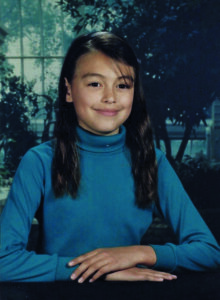
A picture of me in fourth grade in 1994.
I grew up in the busy Los Angeles neighborhood of Boyle Heights filled with vibrant colors, Spanish music coming out of stores, and the smell of taco stands. These colors, sounds, and smells could not mask the lack of service our community faced. According to a Los Angeles Times Boyle Heights profile based on the 2000 census, only 5% of residents 25 and older received a four-year degree. [3] Boyle Heights is also a redlined district that was then beleaguered in order to construct all the freeways that go through it. [4] I grew up in a home that is in front of the 60, 5, 10, and 101 freeway interchange. Our public school system was also poorly served. The public high school I was assigned to, Roosevelt High School, was the second most populated school in the country at the time. Gang violence was also a major problem for those of us who grew up there. Navigating this life was tough.
Thankfully when our younger brother was born, Mom began working as a self-employed sales representative which allowed her to be present in our lives y nos tenía con la cuerda bien cortita. [5] Along with making sure we were safe, Mom had to learn to advocate for us as students. She tells our family that I had always loved school. As a first grader, I was always the first to get home and do my homework and the first to wake everyone up in the morning to go to school. So, when I started crying every morning saying I didn’t want to go to school, she knew something was wrong. She decided to drop me off, walked around the building, and spied on our class through the window! She saw that a small group of students and I were being placed in the back of the room and ignored for most of the class time. Surely enough, she saw me crying in class. Mom walked into the office and gave the principal an earful. The rest of my time at this school was much better. I excelled
in my classes and was asked if I wanted to skip third grade. My family and I decided not to.

A picture of me in middle school in 1999.
Middle school. During my fifth grade, we lived in Mexico for one year so that my siblings and I could attend school there and improve our Spanish. Upon my return, I was ready to enroll in the local public middle school for sixth grade. I spoke with the school counselor who wanted to place me into nothing but development courses. Little did this counselor know that in fifth grade in Mexico, we were doing what seventh graders do here. I channeled my inner Chicana fighter—the same that I felt when watching Stand and Deliver as a young child—and told this counselor that he would be wasting my time. I told him that I would take those classes for one semester and that I would visit him again at the end of the semester and he would need to place me in the correct courses. My courses were changed after the first semester, but I was never told about Magnet or Honors programs while I attended this middle school. The lack of academic expectations from us as students was palpable. I felt that all this school cared about was making sure we survived. I recall being very upset during a so-called pep talk by a visitor to one of my classes. She told us about all the statistics facing our community, like how many of us would die because of gang violence and how many of us girls would be pregnant before completing high school. She then asked who wanted to go to college and I challenged her by saying that she was asking the wrong question. Why not ask us what college we wanted to go to? Even at the young age of fourteen I distinctly remember saying to myself, this is what oppression is. The sheer lack of expectations that we, Chicanx students from Boyle Heights and East L.A., would amount to anything.
Fortunately, I had the pleasure of meeting Mr. Mitchell. He was my eighth-grade fall-semester math teacher. Mr. Mitchell helped me solidify my love for mathematics and encouraged me to apply to a boarding school for high school. He told me that I needed to survive East L.A. and hoped that attending a boarding school would pave a path towards college. I applied to a Southern California boarding school and was invited for an interview. My mother, my best friend, and I traveled in my mom’s shabby 1981 Honda Civic hatchback, which we called Paco, to this interview. My friend and I laughed on our way towards the admissions building as we looked back at my mother’s car parked among shiny BMWs, Lincolns, and Jaguars. As we laughed, my mother told us that we were hurting Paco’s feelings and that he wouldn’t be happy. It was a funny moment, but it helped me quickly realize that I did not belong there. After a full day of interviews and tours, we were finally headed home. It turned out that Paco’s feelings were definitely hurt. The vengeful car did not want to turn on! To put the cherry on top of what felt like an embarrassing day, my friend and I had to push the car downhill so that my mom could kick start it. We got stuck at the bottom of the hill and a campus worker helped us start the car again.

Picture of me in my cross country uniform 2003.
High school. I attended an all-girls Catholic high school where the graduating classes were between 80 and 100 students. This school did not have many resources, but it was the time in which I felt the most empowered. I persisted through family challenges at home. I was trying to study in a 900-square-foot home with seven people in it. For most of the time while I was growing up, we had at least two adult family members from Mexico staying in our home while they worked. Some slept on the floor in the living room, and the light would keep them from sleeping. I resorted to studying in the bathroom. More than ever, I had aspirations to go to college, and I immersed myself in my studies. I was involved in student government, volunteered at the Los Angeles county medical hospital, ran track and cross-country, and was a letterwoman. All first-years took Algebra I. Towards the end of the spring semester we were informed about the school goals to offer the first AP Calculus course. Those of us who wanted the opportunity would need to take Geometry in the summer, so that we could move on to Algebra II our sophomore year, Trig/Pre Calc our junior year, with the finale of AP Calculus our senior year. About thirty young women signed up for this challenge. Some of my most memorable moments in high school are studying for Calculus with my friends at my house while we used my parents’ bedroom mirror as a whiteboard. These instances helped me set my goal to become a math teacher.
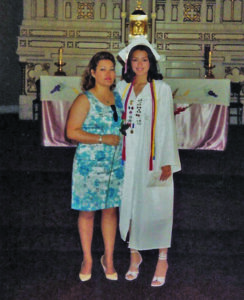
Picture of my mother and me for our senior year mass in 2003.
I wanted to empower students from my community through mathematics. Unfortunately, navigating the college application process was a very distant notion as no one in my family had attended a four-year college. The first time I stepped foot on a college campus was through an outreach program held at Loyola Marymount University. This was a two-week summer program held on campus for high school juniors from underrepresented minority populations chosen for their strong interest and aptitude for math and science. This program helped me feel confident in myself as a student. I applied for college my senior year and accepted the admission to the University of California, Santa Barbara (UCSB).
Higher Education

Picture of the SMI group at Cornell in the summer of 2006.
Undergraduate education. I loved my time at UCSB. Sure, it was quite a big change from my high school—the small class sizes I enjoyed in my high school greatly contrasted the 300+ Calculus II class I took my first quarter. The class sizes, however, were not the only problems I faced. Not only was I one of the few Chicana students in my STEM courses, I constantly felt underestimated and unnoticed. After my first quarter at UCSB, I was speaking with a male student who asked me what my grades were for that quarter. He was very surprised that I earned a higher GPA than he did or that I did better in Calc II than he did. I said to him, “Of course I did; I’m a woman.” I did not know that I was not supposed to be good at math because I am a woman or because I am Mexican-American for that matter. This bias was not touted in my high school. We were all women, the majority of which were Latina, and we did great. Later that same school year, after earning the highest score in a midterm for our Ordinary Differential Equations course, a student from the creative studies college claimed that he would have earned the higher score if he cared about his grade. There are a lot of “little’’ stories like this sprinkled throughout my time as an undergraduate in mathematics. They did start feeling heavier as time went on, but once I formed a strong connection with other math students, I learned to move past those microaggressions.

Picture of Dr. Millett and me at the 2014 SACNAS conference.
I went to UCSB with the intent of getting a mathematics degree in order to go back to teach in my neighborhood. However, during my junior year, a professor, Dr. Kenneth Millett, saw potential in me and many times suggested that I continue my studies. I would tell him that there was no way I was going to get a PhD; my plans were to be an influential math teacher. We would actually argue about this quite a bit. He was worried that I was not letting myself consider a doctoral degree as a possibility, but I was truly concerned about not having a place in that world. At the time, I was having an identity crisis. My family life—the musical, vibrant, tequila-drinking side of me—seemed to clash with what I perceived a mathematician’s world to be. I also looked around the math department and did not see a tenure/tenure-track woman nor an American-born Latinx. I wondered: what does it matter if I get this degree if there is no place for me here? Dr. Millett understood where I was coming from and said that I could help change that. Dr. Millett also said something that I say to my students now. “No matter what your plans are, there is no reason why you should shut doors to programs or opportunities that come your way; you never know what you will discover about yourself.’’

Pancake party at Dr. Stopple’s house for graduating students in math (Dr. Stopple is the third person from the right).
I followed Dr. Millett’s advice by taking a graduate course, and with his and Dr. Jeffrey Stopple’s help, I attended the Conference for Undergraduate Women in Mathematics at the University of Nebraska, Lincoln. Professors Stopple and Millett succeeded in sparking my interests. During the conference, I became curious about research in applied mathematics after listening to many women my age give presentations on the work they had done in summer research programs. I then decided to apply for an REU (Research Experience for Undergraduates) to attend that summer and was fortunately accepted to the Summer Math Institute (SMI) at Cornell. SMI was an intense eight-week program designed to help prepare participants for the rigors of graduate school by having a course in real analysis and a research project. I was consumed in mathematics from 8:00am until midnight every day and I loved it. This program also helped me realize that I had the endurance that a graduate program demands.
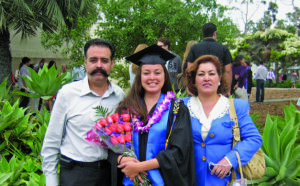
Picture of my parents and me at my BS graduation at UCSB in 2007.
I’ll never forget getting back to UCSB that fall and talking with Dr. Millett. He asked, “Well?” I said, “I’m thinking about applying to graduate school.” He smirked and nodded his head. Till this day I can see him patting himself on the back. However, I still wondered if I belonged. That is where the Society for the Advancement of Chicanos and Native Americans in Science (SACNAS) organization made a lasting impact. The research mentors at SMI had applied for us to attend the SACNAS conference that October. In October of 2006, the fall of my senior year at UCSB, I attended my first annual SACNAS National Conference. It was a life-changing experience. I walked into a room of 3000 scientists, academics, and professionals who looked just like me and who had lived through similar struggles as my own. SACNAS gave me that push I needed. I attended the many professional development sessions that were aimed for students applying to graduate school. I learned of the application process and what things to look for in a program. Attending this conference helped me make the decision to apply to graduate programs. I knew that I had formed an academic family, one that would support me and help guide me as I took on this endeavor.
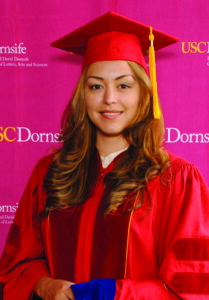
Picture at my PhD hooding ceremony in 2013.
Graduate education. I was fortunate to gain acceptances to several graduate programs and decided on attending the University of Southern California in Los Angeles. My early years as a graduate student were the most difficult of my career. I felt that a mistake was made in admitting me and that the program was not prepared for a student like me. I was honored to receive a Provost Fellowship which funded my graduate studies and included a reduced graduate teaching load. However, it is the mentoring and the support network that I needed the most. In an incoming cohort of 20 students, there were only four of us that had been admitted with bachelor’s degrees from an undergraduate institution in the United States. The rest of the students were those with master’s degrees or international students. Most of the students were much more advanced than I was even though I had taken a graduate course and conducted research as an undergraduate. This made it very difficult to find a group of students to work with during my first year. I questioned my future in the program every day. Fortunately, I completed my coursework and qualifying exams. At the same time, I had formed a support network outside of the department with Latinx graduate students in STEM programs. We formed the first SACNAS chapter at USC. While working on my research, I also felt quite isolated. My advisor was the only tenure-track faculty member working in this research area, and I was his only graduate student. There were no seminars that I could create with peers so that we could help each other advance in our work.

Picture of my family at Yosemite in 2018.
I was a graduate TA from my third year through my sixth. I was happy to learn from this experience that I truly loved to teach. I was awarded the Department of Mathematics Denis Ray Estes Graduate Teaching Prize and was the single departmental nominee for the University Outstanding TA Award.
During my fourth year of the program, I married my husband, Raul, and we welcomed our son a year later. We supported each other through our new role as parents, and he was incredibly encouraging as I continued my studies. I now had an even stronger motivation to complete my degree and pursue my career as an educator. Soon after graduation, we learned that we were expecting our second child. I felt that it was too much to move around and was supported by the USC mathematics department as I obtained a lecturer position for a year. I then traveled with my four-week old daughter across the country as I interviewed for positions, and I am very grateful for those institutions that adapted their schedules for me and my daughter.
Some advice for students regarding graduate school. I knew that graduate school was going to be very difficult, and I felt that having my family nearby would be important. However, it did not matter that my parents were just a drive away. All they could do for me when I was stressed and thinking about quitting (which was daily), was say “it’ll be OK, mija.” [6] They could have done that over the phone. I ask students to think about how important they think the location of the school is versus a program that is intentional about mentoring their graduate students, that cares about learning who their graduate students are, and creates opportunities for their professional development while they obtain their degree.
The research that is conducted during your PhD is not the be-all-end-all. I am one of several faculty who has changed their research focus from their dissertation. There are some overlaps, but the majority of the research that I have conducted over the past six years is not related to the work I conducted as a graduate student.
Current
Research. My research interests lie in the fields of differential and difference equations, dynamical systems and its applications to mathematical biology. I am interested in the insights that mathematics has on biology and vice-versa. I have had the privilege of working with biologists who express how they would like mathematics to inform their work.
I consider myself incredibly fortunate to have participated in the Women in Applied Mathematics research collaboration group that was hosted by the Institute for Mathematics and its Applications (IMA) at the University of Minnesota the summer I completed my PhD. I joined a group of six female mathematical biologists and mathematical modelers to conduct research on the effects of thermoregulation on sleep. Human sleep is divided into two physiologically different stages: rapid eye movement (REM) sleep and non-rapid eye movement (NREM) sleep. NREM sleep is a state of reduced brain activity which includes deep slow-wave sleep. REM is the stage where we have our most vivid dreams and our brain metabolism is as high as during wake. However, REM is distinguished from both NREM and wake by an absence of muscle tone and a suspension of thermoregulation. In our work we develop a model for REM and NREM dynamics with sleep/wake cycling by building on recent neurophysiological models and answer questions regarding ambient temperature and human sleep. I am especially grateful for the friendships that have been formed with Drs. Shelby Wilson, Alicia Prieto-Langarica, Pamela Pyzza, Gemma Huguet, and Janet Best. The support and camaraderie in this group has been essential for my success.
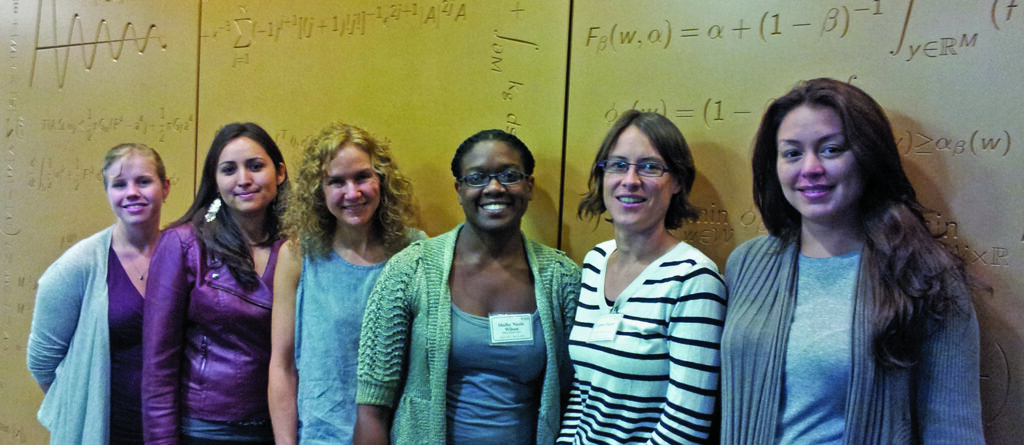
From left to right: Pamela Pyzza, Alicia Prieto-Langarica, Janet Best, Shelby Wilson, Gemma Huguet, and me at the Institute for Mathematics and its Applications in 2013.
Another project I am involved with is in the area of mathematical epidemiology. Zika is a vector-borne disease similar to Dengue or Chikungunya; however, due to the possibility of sexual transmission, other models are no longer applicable. We created a model of the spread of Zika that was then used to determine the basic reproductive number with and without the effect of sexual transmission; we estimated unknown parameters via Latin Hypercube Sampling and analyzed the sensitivity of the parameters. We also implemented a simple version of control using Wolbachia bacterium the analysis of which was conducted by the targeted reproductive number. This work was supported by two SACNAS collaboration mini-grants and I also guided two master’s students through their thesis in this work.
I advised a group of seven undergraduate students in a research project along with Dr. Cynthia Flores during the 2016–2017 academic year. The research project explored the dynamics of classes of voters by taking a mathematical epidemiology approach. Guiding this group of undergraduate students really helped me in my fundamental understanding of modeling the spread of diseases, which aided our Zika virus research. I learned where to begin guiding future research students on epidemiology projects.
Final Thoughts
For some time I believed that all first generation, Latinx, or low-income students needed were opportunities and ganas [7]. But, after years of reflecting on my upbringing and my career path, I noticed that many things had to align for me to get to where I am. Growing up in Boyle Heights I could have been in the wrong place at the wrong time as were some of my friends. I also ask myself, what would have happened if Dr. Millett or Dr. Stopple had not taken an interest in my future? I could have stopped at my BS degree without knowing that I was capable of more. How many students don’t have a Dr. Millett or a Dr. Stopple? I opine that STEM departments in higher education should have systems in place for students to be mentored so that this work does not fall on only a few faculty.
I am often asked by students how I shook off the impostor syndrome. My reply is always the same: I have not. I asked a mentor of mine who I greatly admire the same question. I was very surprised to hear that she still feels the same way. I was flabbergasted. Here was this amazing leader, incredibly hard-working, equity-minded mentor saying she hasn’t shaken it. I had a range of emotions because of her honest response. I first felt sad thinking that I will always feel like I do not belong or that my work is never enough. But after a lengthy conversation with her, I learned how to channel that emotion and feel empowered. Maybe the impostor syndrome doesn’t stop, but I have not let it stop me either.
Some of you may also receive sly remarks insinuating that you have not earned your position due to your ethnicity or gender. Here are two comments I have for that: 1) I have been fortunate in having choices for positions along my career. I knew I would earn a job somewhere and there will always be at least one person in each of those places that will have that thought. 2) If we operate under the assumption that I was hired because I am a Mexican-American woman in mathematics, it is not the reason why I have earned the retention each year. My teaching, research, service, and viewing mentoring of underrepresented students as an essential part of my career are the reasons.
[1] A small town.
[2] A Mexican laborer allowed into the U.S. for a limited time as a seasonal agricultural worker.
[3] maps.latimes.com/neighborhoods/neighborhood/boyle-heights/
[4] tinyurl.com/rdong9u; https://tinyurl.com/y5v58z3z
[5] It translates to “and she had us on a short leash,’’ meaning that she kept a very close eye on us.
[6] My daughter.
[7] The will to succeed.
Previous Testimonios:
